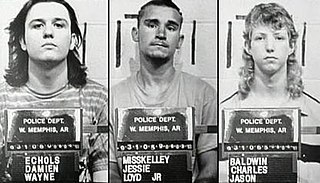
The West Memphis Three are three men convicted as teenagers in 1994 of the 1993 murders of three boys in West Memphis, Arkansas, United States. Damien Echols was sentenced to death, Jessie Misskelley Jr. to life imprisonment plus two 20-year sentences, and Jason Baldwin to life imprisonment. During the trial, the prosecution asserted that the juveniles killed the children as part of a Satanic ritual.

Kevin Cooper is an American Mass Murderer currently on death row at San Quentin Prison. Cooper was found guilty of four murders in the Chino Hills area of California in 1983. Cooper's conviction has garnered repeated attention from both Nicholas Kristof in the New York Times and Erin Moriarty on the CBS News program "48 Hours." There have been accusations that Cooper received an inadequate defense, as well as prosecutorial misconduct such as destruction of evidence, withholding exculpatory evidence from the defense, planting of evidence, brainwashing to witnesses, and perjured testimony by the Sheriff's Department. There have also been practical questions raised, such as how Cooper, at 155 pounds, and allegedly acting alone, overpowered a 6-foot, 2-inch ex-military policeman and his athletic wife, both of whom had loaded firearms close at hand. It has also been questioned why a single perpetrator would use 3 or 4 different weapons to commit the murders, and why none of the victims were able to run away while the others were being attacked.

Barry Charles Scheck is an American attorney and legal scholar. He received national media attention while serving on O. J. Simpson's defense team, collectively dubbed the "Dream Team", helping to win an acquittal in the highly publicized murder case. Scheck is the director of the Innocence Project and a professor at Yeshiva University's Benjamin N. Cardozo School of Law in New York City.
Steven Allan Avery is an American convicted murderer from Manitowoc County, Wisconsin, who had previously been wrongfully convicted in 1985 of sexual assault and attempted murder. After serving 18 years of a 32-year sentence, Avery was exonerated by DNA testing and released in 2003, only to be charged with murder two years later.
Actual innocence is a special standard of review in legal cases to prove that a charged defendant did not commit the crimes that they were accused of, which is often applied by appellate courts to prevent a miscarriage of justice.
False evidence, fabricated evidence, forged evidence, fake evidence or tainted evidence is information created or obtained illegally in order to sway the verdict in a court case. Falsified evidence could be created by either side in a case, or by someone sympathetic to either side. Misleading by suppressing evidence can also be considered a form of false evidence ; however, in some cases, suppressed evidence is excluded because it cannot be proved the accused was aware of the items found or of their location. The analysis of evidence may also be forged if the person doing the forensic work finds it easier to fabricate evidence and test results than to perform the actual work involved. Parallel construction is a form of false evidence in which the evidence is truthful but its origins are untruthfully described, at times in order to avoid evidence being excluded as inadmissible due to unlawful means of procurement such as an unlawful search.

Roger Keith Coleman was a convicted murderer and rapist from Grundy, Virginia, USA, who was executed for the rape and murder in March 1981 of his sister-in-law, Wanda McCoy. That day, he had been laid off from work.
Henry Watkins Skinner was an American death row inmate in Texas. In 1995, he was convicted of bludgeoning to death his live-in girlfriend, Twila Busby, and stabbing to death her two adult sons, Randy Busby and Elwin Caler. On March 24, 2010, twenty minutes before his scheduled execution, the U.S. Supreme Court issued a stay of execution to consider the question of whether Skinner could request testing of DNA his attorney chose not to have tested at his original trial in 1994. A third execution date for November 9, 2011, was also ultimately stayed by the Texas Court of Criminal Appeals on November 7, 2011.
Frederick Salem Zain was an American forensic laboratory technician in West Virginia and Bexar County, Texas, who falsified serology results to obtain convictions.
James Calvin Tillman is a man who was wrongfully convicted of rape, and served 18.5 years in prison before being exonerated by DNA testing on July 11, 2006. Tillman, of East Hartford Connecticut, was convicted of kidnapping in the first degree, sexual assault in the first degree, robbery and assault in the third degree in 1989, and freed in 2007.
Sharon Faye Keller is the Presiding Judge of the Texas Court of Criminal Appeals. She is a Republican.
Schlup v. Delo, 513 U.S. 298 (1995), was a case in which the United States Supreme Court expanded the ability to reopen a case in light of new evidence of innocence.
Payne v. Tennessee, 501 U.S. 808 (1991), was a United States Supreme Court case which held that testimony in the form of a victim impact statement is admissible during the sentencing phase of a trial and, in death penalty cases, does not violate the Cruel and Unusual Punishment Clause of the Eighth Amendment. Payne narrowed two of the Courts' precedents: Booth v. Maryland (1987) and South Carolina v. Gathers (1989).
Rolando Cruz is an American man known for having been wrongfully convicted and sentenced to death, along with co-defendant Alejandro Hernandez, for the 1983 kidnapping, rape, and murder of 10-year-old Jeanine Nicarico in DuPage County, Illinois. The police had no substantive physical evidence linking the two men to the crime. Their first trial was jointly in 1987, and their statements were used against each other and a third defendant.
Willie Jerome "Fly" Manning is on death row at Mississippi State Penitentiary, USA, with two death sentences for a conviction of double murder. He was previously also convicted and sentenced to death for an unrelated double murder, but the State Supreme Court overturned this verdict and ordered a new trial. The charges against him for the Jimmerson-Jordan murders were then dropped, and the Death Penalty Information Center listed him as a 2015 death row exoneree for this case.

Juan A. Rivera Jr. is an American man who was wrongfully convicted three times for the 1992 rape and murder of 11-year-old Holly Staker in Waukegan, Illinois. He was convicted twice on the basis of a confession that he said was coerced. No physical evidence linked him to the crime scene. In 2015 he received a $20 million settlement from Lake County, Illinois for wrongful conviction, formerly the largest settlement of its kind in United States history.

Making a Murderer is an American true crime documentary television series written and directed by Laura Ricciardi and Moira Demos. The show tells the story of Steven Avery, a man from Manitowoc County, Wisconsin, who served 18 years in prison (1985–2003) after his wrongful conviction for the sexual assault and attempted murder of Penny Beerntsen. He was later charged with and convicted of the 2005 murder of Teresa Halbach. The connected story is that of Avery's nephew Brendan Dassey, who was accused and convicted as an accessory in the murder of Halbach.
With no witnesses to the murders of Nicole Brown Simpson and Ron Goldman, DNA evidence in the O. J. Simpson murder case was the key physical proof used by the prosecution to link O. J. Simpson to the crime.
The Eastburn family murders were the murders of Kathryn "Katie" Eastburn and her daughters, Kara and Erin, which occurred in Fayetteville, North Carolina, in May 1985. In 1986, United States Army Sergeant Timothy Hennis was tried and convicted for the three murders. In 1988, Hennis's conviction was overturned on appeal, and he was acquitted the following year. In 2006, the Cumberland County Sherriff's Office obtained DNA evidence linking Hennis to the crime. Despite the Fifth Amendment's Double Jeopardy Clause prohibiting retrials after acquittals, the United States Army was able to initiate prosecution and trial proceedings against Hennis under the dual sovereignty doctrine. In 2010, Hennis was tried and convicted by an Army court-martial for the triple murders and sentenced to death.







